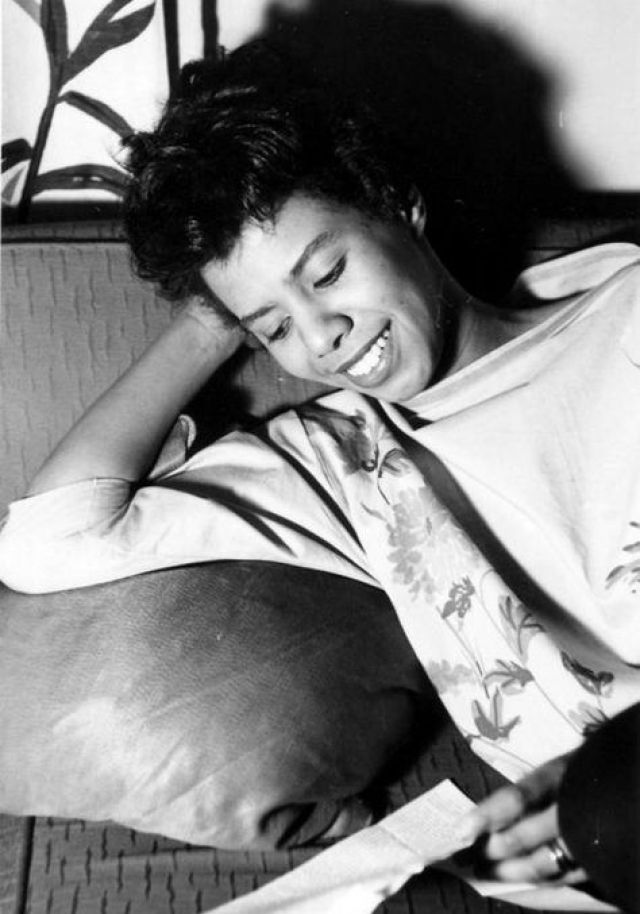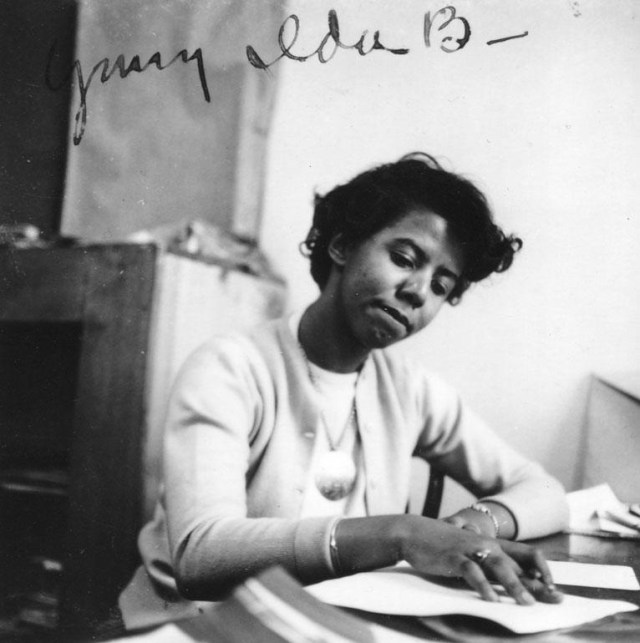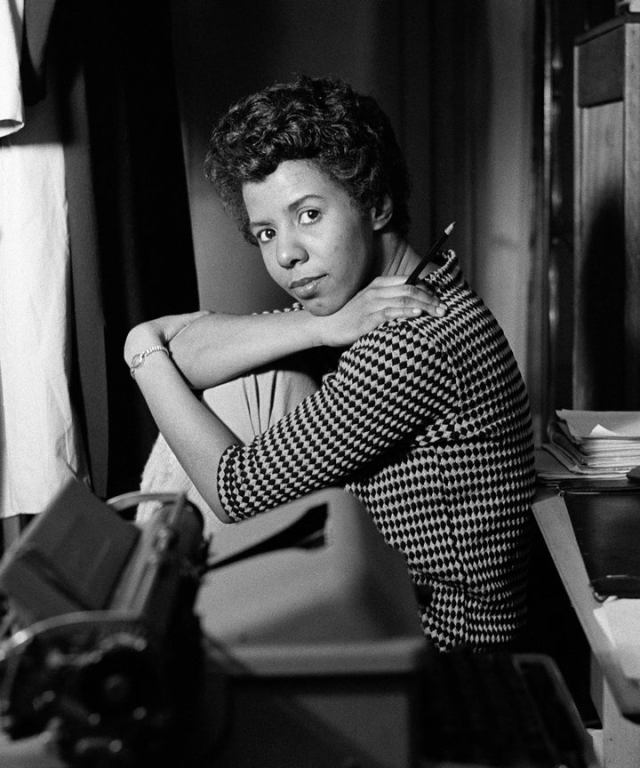
Welcome to Autostraddle’s 2020 Black History Month Series, a deliberate celebration of black queer clarity of vision and self-determination.
“Lorraine Hansberry is a problem to me because she is Black, female and dead,” the feminist lesbian writer Adrienne Rich once wrote. She meant it less as a criticism for Hansberry and more as a lament that she was gone so soon and that the work she’d left behind had been adapted by Hansberry’s ex-husband and literary executor, Robert Nemiroff. Rich wondered where Hansberry’s hand ended and where Nemiroff’s began.
“So many of the truths of women’s lives, so much of women’s writings, have come to us in fragments, over time, that for decades their work is half-understood and we have only clues about their real stature,” Rich continued.
The time Rich longed for — that moment where we piece together the works of Lorraine Hansberry to appreciate her real stature — may finally be here.
With increased access to her papers, black feminists are helping “us see [Hansberry] unidealized, unsimplified, in her fullest complexity, in her fullest political context.” Hansberry is afforded that context in Mary Helen Washington’s The Other Blacklist: The African American Literary and Cultural Left of the 1950s. We see her unidealized and unsimplified in Tracy Strain’s award-winning documentary, Sighted Eyes/Feeling Heart and within the pages of Imani Perry’s “third-person memoir,” Looking for Lorraine, Hansberry is given her fullest complexity.
That said, as someone who is interested in how one of the most celebrated black women of her time, grappled with her race, gender and sexuality at the same time, Lorraine Hansberry remains something of a problem for me. The question of her sexuality does not exist in my mind: There is sufficient evidence, both from Hansberry’s own hand and anecdotally from those with whom she interacted socially, that Hansberry was a lesbian. But the how of it all — how did she know, how did she feel about her lovers, how did she reconcile her identities, how did she end up married — we have to piece together in fragments.
![]()

Born in 1930, Lorraine Vivian Hansberry was the youngest of Carl and Nannie Hansberry’s four children. To those around them, the Hansberrys were inspirational — both parents were college educated with thriving careers, Carl as a real estate mogul, Nannie as a teacher and political activist. However, because they lived in a world that stymied black advancement through segregation and discrimination, the Hansberrys were forced to live in Chicago’s South Side ghettos like everyone else.
Lorraine grew up isolated as a child. As older siblings are wont to do, Lorraine’s refused to spend time with her. Even her parents kept an emotional distance from their daughter: keeping her provided for materially, but refusing to coddle their children, even when sick.
Carl and Nannie Hansberry were not strangers to the harshness of the world. In 1937, they sought to buy a home in a white neighborhood and were inundated with threat as they engaged in three year long legal battle that would ultimately be resolved by the Supreme Court. Their utilitarian style of parenting was, seemingly, their way of preparing their children to exist in that world. But Lorraine craved emotional connection, an opportunity lost forever when her father died unexpectedly when she was just 16. In hindsight, it feels as though the rest of her life was a persistent chase for that connection.
While she eschewed a number of her parents’ political ideals — they were purveyors of “respectability politics” before that even was a thing — Lorraine understood activism as part of her calling too. She led the debate team in high school, studied local and global politics and committed herself to becoming a journalist. She graduated from Englewood High School in 1948, intent on attending the University of Wisconsin at Madison, when someone leaves this message in her yearbook:
Dear Lorraine,
These years I’ve known you have been the most wonderful in all my life. You don’t know how I lived for each day when I could come to school each morning and behold your wonderful face. And now that we are parting I don’t know how I will go on. Please hurry back to me Dear one. I would like to murder you.
Yours always,
The signature is scratched out — perhaps intentionally, perhaps not — and, thus the author’s name remains unknown. But while Perry chalks it up to “adolescent melodramatic form,” the note reads queer to me… the byproduct of young love, driven apart by time and chance. It’s the first piece of evidence we’re given that Lorraine might be something other than straight.
![]()

Lorraine Hansberry at Freedom magazine, via The Lorraine Hansberry Literary Trust
Hansberry didn’t last long in Madison, staying at UW for just two years before dropping out, but she was gifted a tremendous education in those years. She shifted her focus away from journalism and to applied arts. She was exposed to Sean O’Casey, an Irish playwright, who perhaps inspired her style more than anyone else. From O’Casey she drew the boldness to tell very specific stories that exposed “the human personality and its totality.” She’d grown up internalizing the message from her parents that every success and every failure reflected on the race and that made its way into her writing. Through O’Casey she came to understand, as Perry points out, “she didn’t have to think about positive and negative representations but rather simply true ones.”
Hansberry embroiled herself in politics in a way she hadn’t (or couldn’t) before and traveled to Mexico. In the bohemian city of Ajijic, Lorraine found a place to mourn — her father had intended to move his family to Mexico but, instead, he died there — and a place to find peace, surrounded by people more like her… including, presumably, other gay women. That desire to belong may have driven her out of Madison and, ultimately, led her to New York City — first to Greenwich, then to Harlem — in 1950. It’s here that Hansberry’s lesbianism became a fixed (but still hidden) part of her identity.
She found herself in Harlem: becoming a journalist at Paul Robeson’s newspaper, Freedom, joining protests and committing herself to the Communist Party. Her connections brought her to the attention of the FBI. They stripped her of her passport and began their surveillance of her in 1952. Around that same time, she met Robert “Bobby” Nemiroff at a protest against racially discriminatory hiring practices at New York University. He shared her politics, intellectualism and a passion for the arts. He immediately grew smitten, but Lorraine took a bit longer to warm to the idea.
My Dear Bob,
Once again I wrote you a very long letter — the important simple things which it said were that I have finally admitted to myself I do love you, you wide-eyed immature un-sophisticated revolutionary.
Nemiroff didn’t make the earth move, Hansberry wrote in a thinly veiled reference to For Whom the Bell Tolls, but her “sincerest political opinion is that we have reached a point in a truly beautiful relationship — where it may become the fullest kind of relationship between a man and a woman.” They married in June 20, 1953 in Chicago, after having spent the night before protesting the execution of Julius and Ethel Rosenberg. Their love felt more practical that poetic. He gave her the emotional connection that she craved, financial support when she needed it and kept her her disciplined with her work. I remain uncertain what he got from her in return.
During her periods of loneliness and depression, Hansberry leaned on Nemiroff but also sought refuge in books, particularly Simone de Beauvoir’s The Second Sex. Though they disagreed on some things, Hansberry found a compatriot on those pages… someone who, like her, rejected expectation and who carved out a space where questions of race, gender and sexuality could exist simultaneously. She’d pen Flowers for the General, wherein a college student named Marcia falls in love with her classmate, Maxine. Marcia tries kill herself when she’s outed to the entire school and Maxine comforts her. Marcia reveals that she knows Maxine’s also attracted to women too. Maxine confirms her attraction but is determined to marry her boyfriend anyway. Basically, Lorraine Hansberry wrote Lost and Delirious… but in 1956.
![]()

The next year, Hansberry’s life changed dramatically: She hosted a dinner party to share the first draft of the play that became A Raisin in the Sun and was offer a deal on the spot. She and Nemiroff quietly separated (they wouldn’t divorce until 1964) and Hansberry began her most direct engagement with the queer community to date. She joined the the lesbian organization, Daughters of Bilitis, and would, in November 1958, host the group’s founders Del Martin and Phyllis Lyon at her home. When DOB began publishing Ladder, a magazine about the lives of lesbian women, she wrote in — first contributing letters signed with her married initials, L.H.N. or L.N., then contributing a short story called “Chanson du Konallis” under the nom de plume, Emily Jones. Those letters would out Hansberry after her death, when The Ladder‘s former editor, Barbara Grier, identified her as the author in 1976. From Hansberry’s second letter to Ladder:
I think it is about time that equipped women began to take on some of the ethical questions which a male-dominated culture has produced and dissect and analyze them quite to pieces in a serious fashion. It is time that ‘half the human race’ had something to say about the nature of its existence. Otherwise — without revised basic thinking — the woman intellectual is likely to find herself trying to draw conclusions — moral conclusions — based on acceptance of a social moral superstructure which has never admitted to the equality of women and is therefore immoral itself.
She — or, Emily Jones, rather — would also pen three short stories for ONE, the nation’s oldest magazine featuring the “homosexual viewpoint,” “The Budget,” “The Anticipation of Eve” and “Renascence,” all as Raisin in the Sun worked towards its Broadway debut. As she wrote more queer characters, her desire to experience that life for herself grew and she finally ventured out into lesbian society.
Hansberry went to house parties in the Village and on the Upper East Side with Edith Windsor, Louise Fitzhugh and Patricia Highsmith. In Looking for Lorraine, Perry offers scant details of Hansberry’s love affair with Molly Malone Cook, Renee Kaplan, Dorothy Secules and Ann Grifalconi. Cook would go onto have an epic 40 year romance with poet Mary Oliver but her relationship with Hansberry came first. In fact, Perry suspects that Oliver mentions it, without naming Hansberry outright, in their book, Our World.
[Cook] had… an affair that struck deeply; I believe she loved totally and was loved totally. I know about it, and I am glad… This love, and the ensuing emptiness of its ending, changed her. Of such events we are always changed — not necessarily badly, but changed. Who doesn’t know this doesn’t know much.
Elise Harris provided, perhaps, the best roadmap of Hansberry’s romantic relationships in her 1999 piece for Out magazine, “The Double Life of Lorraine Hansberry.” Without access to Hansberry’s personal musings (those documents weren’t accessible until 2010), Harris reached out to the lesbian community in New York City.
“She was intellectually such a genius that her emotional life didn’t catch up,” Marie Rupert told Harris. “If she had lived longer, there would have been a developing and growing. She would have been more able to cope with the conflicting aspects of her nature.”
Harris goes into detail about Hansberry’s relationship with Renee Kaplan, a two-year affair that began soon after the Broadway debut of Raisin. Kaplan’s recollections paint the image of a Lorraine Hansberry that is unburdened and carefree: relaxing and reading Langston Hughes, building snowmen and making snow angels in the snow. They broke up — “sexually it was not a great relationship,” Kaplan told Harris — but the two remained friends until Hansberry’s death.
There was a similar lightness to Hansberry when she met Dorothy Secules, a resident of the building that Hansberry bought with the money from Raisin. In Secules, Hansberry found a “woman of accomplishment” and someone who loved politics as much as she did but also knew how to have fun.
“The four of us would have grand times,” her friend, Miranda d’Ancona, recalled. “I remember Lorraine lined us up, all three of us, she in front, to teach us [the latest dance]. We all collapsed laughing; it turned into total silliness. That was the part of Lorraine that was so irresistible, where her intellect could take a rest for a while and just enjoy the fun of the evening.”
What we know of Hansberry’s relationship with Secules suggests that it was contentious, in part because Nemiroff sought to maintain his hold on her, but on her deathbed, Harris reports, Hansberry confessed her love for Secules.
As someone who once included her homosexuality on a list of things she liked and hated, it was a final reconciliation of her life’s great truths.

Thank you for this thoughtful essay. I was just having this discussion with a fellow teacher who taught Queer history last summer and included the latest biography of Pauli Murray in the reading list. How do we identify a person who privately thought of themselves as a “boy/girl?” Were they trans or NB? Would that have changed if they were alive today? How do we situate their relationship with a woman in that context? And do we have the right to make these distinctions posthumously? My friend’s students opted for NB and “they/them” pronouns, a position I tentatively agree with, but I’d be interested to hear others’ thoughts on this.
I am so so happy to see Lorraine Hansberry here! I adore her work, her brain, and Imani Perry’s biography of her. I love imagining her and James Baldwin hanging out, the incredible social circles of the day. Thank you for this!
thank you
I simply cannot get enough of Lorraine Hansberry! The fact that she and James Baldwin were besties is simply too much for my heart and mind to comprehend sometimes. Thank you for writing this.
Natalie! Thank you. I love this so much. I appreciate this deep dive into Lorraine’s love life.
Also forever signing my letters “Please hurry back to me Dear one. I would like to murder you.”
What a wonderful mini-biography. A truly impressive woman, and I hope more pieces can be put together about her story.
“Please hurry back to me Dear one. I would like to murder you.” Is the gayest teen love letter I have EVER read!!!
But seriously, Natalie I absolutely adore this well researched, deep dive into Lorraine Hansberry’s life and letters and love. I’ve always felt kinship with her, and it’s a real honor and delight whenever there’s an opportunity to learn more. Thank you! (And Happy Black History Month!)
This is so good!! Thank you Natalie!
An incredible story of a strong personality.
Glad to be able to be inspired by strong-minded people.